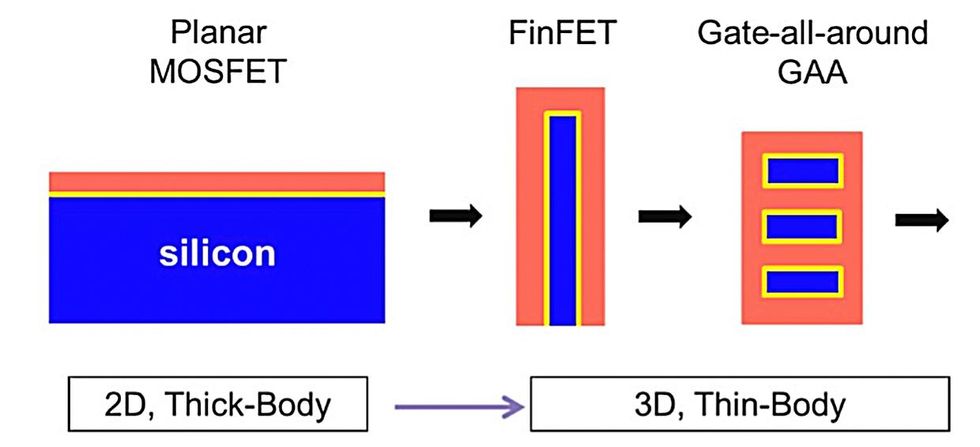The Future of the Transistor Is Our Future
This is a guest post in recognition of the 75th anniversary of the invention of the transistor. It is adapted from an essay in the July 2022 IEEE Electron Device Society Newsletter. The views expressed here are solely those of the author and do not represent positions of IEEE Spectrum or the IEEE.
On the 75th anniversary of the invention of the transistor, a device to which I have devoted my entire career, I'd like to answer two questions: Does the world need better transistors? And if so, what will they be like?
This article is part of our special report on the 75th anniversary of the invention of the transistor.
I would argue, that yes, we are going to need new transistors, and I think we have some hints today of what they will be like. Whether we'll have the will and economic ability to make them is the question.
I believe the transistor is and will remain key to grappling with the impacts of global warming. With its potential for societal, economic, and personal upheaval, climate change calls for tools that give us humans orders-of-magnitude more capability.
Semiconductors can raise the abilities of humanity like no other technology. Almost by definition, all technologies increase human abilities. But for most of them, natural resources and energy constraints make orders-of-magnitude improvements questionable. Transistor-enabled technology is a unique exception for the following reasons.
- As transistors improve, they enable new abilities such as computing and high-speed communication, the Internet, smartphones, memory and storage, robotics, artificial intelligence, and other things no one has thought of yet.
- These abilities have wide applications, and they transform all technologies, industries, and sciences.
a. Semiconductor technology is not nearly as limited in growth by its material and energy usages as other technologies. ICs use relatively small amounts of material. And the less material they use, by being made even smaller, the faster, more energy efficient, and capable they become. - Theoretically, the energy required for information processing can still be reduced to less than one-thousandth of what is required today. Although we do not yet know exactly how to approach such theoretical efficiency, we know that increasing energy efficiency a thousandfold would not violate physical laws. In contrast, the energy efficiencies of most other technologies, such as motors and lighting, are already at 30 to 80 percent of their theoretical limits.
How we'll continue to improve transistor technology is relatively clear in the short term, but it gets murkier the farther out you go from today. In the near term, you can glimpse the transistor's future by looking at its recent past.
The basic planar (2D) MOSFET structure remained unchanged from 1960 until around 2010, when it became impossible to further increase transistor density and decrease the device's power consumption. My lab at the University of California, Berkeley, saw that point coming more than a decade earlier. We reported the invention of the FinFET, the planar transistor's successor, in 1999. FinFET, the first 3D MOSFET, changed the flat and wide transistor structure to a tall and narrow one. The benefit is better performance in a smaller footprint, much like the benefit of multistory buildings over single-story ones in a crowded city.
The FinFET is also what's called a thin-body MOSFET, a concept that continues to guide the development of new devices. It arose from the insight that current will not leak through a transistor within several nanometers of the silicon surface because the surface potential there is well controlled by the gate voltage. FinFETs take this thin-body concept to heart. The device's body is the vertical silicon fin, which is covered by oxide insulator and gate metal, leaving no silicon outside the range of strong gate control. FinFETs reduced leakage current by orders of magnitude and lowered transistor operating voltage. It also pointed toward the path for further improvement: reducing the body thickness even more.
The fin of the FinFET has become thinner and taller with each new technology node. But this progress has now become too difficult to maintain. So industry is adopting a new 3D thin-body CMOS structure, called gate-all-around (GAA). Here, a stack of ribbons of semiconductor make up the thin body.
 Each evolution of the MOSFET structure has been aimed at producing better control over charge in the silicon by the gate [pink]. Dielectric [yellow] prevents charge from moving from the gate into the silicon body [blue].
Each evolution of the MOSFET structure has been aimed at producing better control over charge in the silicon by the gate [pink]. Dielectric [yellow] prevents charge from moving from the gate into the silicon body [blue].
The 3D thin-body trend will continue from these 3D transistors to 3D-stacked transistors, 3D monolithic circuits, and multichip packaging. In some cases, this 3D trend has already reached great heights. For instance, the regularity of the charge-trap memory-transistor array allowed NAND flash memory to be the first IC to transition from 2D circuits to 3D circuits. Since the first report of 3D NAND by Toshiba in 2007, the number of stacked layers has grown from 4 to more than 200.
Monolithic 3D logic ICs will likely start modestly, with stacking the two transistors of a CMOS inverter to reduce all logic gates' footprints [see 3D-Stacked CMOS Takes Moore's Law to New Heights"]. But the number of stacks may grow. Other paths to 3D ICs may employ the transfer or deposition of additional layers of semiconductor films, such as silicon, silicon germanium, or indium gallium arsenide onto a silicon wafer.
The thin-body trend might meet its ultimate endpoint in 2D semiconductors, whose thickness is measured in atoms. Molybdenum disulfide molecules, for example, are both naturally thin and relatively large, forming a 2D semiconductor that may be no more than three atoms wide yet have very good semiconductor properties. In 2016, engineers in California and Texas used a film of the 2D-semiconductor molecule molybdenum disulfide and a carbon nanotube to demonstrate a MOSFET with a critical dimension: a gate length just 1 nanometer across. Even with a gate as short as 1 nm, the transistor leakage current was only 10 nanoamperes per millimeter, comparable with today's best production transistor.
The progress of transistor technology has not been even or smooth."
One can imagine that in the distant future, the entire transistor may be prefabricated as a single molecule. These prefabricated building blocks might be brought to their precise locations in an IC through a process called directed-self-assembly (DSA). To understand DSA, it may be helpful to recall that a COVID virus uses its spikes to find and chemically dock itself onto an exact spot at the surface of particular human cells. In DSA, the docking spots, the spikes," and the transistor cargo are all carefully designed and manufactured. The initial docking spots may be created with lithography on a substrate, but additional docking spots may be brought in as cargo in subsequent steps. Some of the cargo may be removed by heat or other means if they are needed only during the fabrication process but not in the final product.
Besides making transistors smaller, we'll have to keep reducing their power consumption. Here we could see an order-of-magnitude reduction through the use of what are called negative-capacitance field-effect transistors (NCFET). These require the insertion of a nanometer-thin layer of ferroelectric material, such as hafnium zirconium oxide, in the MOSFET's gate stack. Because the ferroelectric contains its own internal electric field, it takes less energy to switch the device on or off. An additional advantage of the thin ferroelectric is the possible use of the ferroelectric's capacity to store a bit as the state of its electric field, thereby integrating memory and computing in the same device.
 The author [left] received the U.S. National Medal of Technology and Innovation from President Barack Obama [right] in 2016.Kevin Dietsch/UPI/Alamy
The author [left] received the U.S. National Medal of Technology and Innovation from President Barack Obama [right] in 2016.Kevin Dietsch/UPI/Alamy
To some degree, the devices I've described arose out of existing trends. But future transistors may have very different materials, structures, and operating mechanisms from those of today's transistor. For example, the nanoelectromechanical switch is a return to the mechanical relays of decades past rather than an extension of the transistor. Rather than relying on the physics of semiconductors, it uses only metals, dielectrics, and the force between closely spaced conductors with different voltages applied to them.
All these examples have been demonstrated with experiments years ago. However, bringing them to production will require much more time and effort than previous breakthroughs in semiconductor technology.
Getting to the futureWill we be able to achieve these feats? Some lessons from the past indicate that we could.
The first lesson is that the progress of transistor technology has not been even or smooth. Around 1980, the rising power consumption per chip reached a painful level. The adoption of CMOS, replacing NMOS and bipolar technologies-and later, the gradual reduction of operation voltage from 5 volts to 1-gave the industry 30 years of more or less straightforward progress. But again, power became an issue. Between 2000 and 2010, the heat generated per square centimeter of IC was projected by thoughtful researchers to soon reach that of a nuclear-reactor core. The adoption of 3D thin-body FinFET and multicore processor architectures averted the crisis and ushered in another period of relatively smooth progress.
The history of transistor technology may be described as climbing one mountain after another. Only when we got to the top of one were we able see the vista beyond and map a route to climb the next taller and steeper mountain.
The second lesson is that the core strength of the semiconductor industry-nanofabrication-is formidable. History proves that, given sufficient time and economic incentives, the industry has been able to turn any idea into reality, as long as that idea does not violate scientific laws.
But will the industry have sufficient time and economic incentives to continue climbing taller and steeper mountains and keep raising humanity's abilities?
It's a fair question. Even as the fab industry's resources grow, the mountains of technology development grow even faster. A time may come when no one fab company can reach the top of the mountain to see the path ahead. What happens then?
The revenue of all semiconductor fabs (both independent and those, like Intel, that are integrated companies) is about one-third of the semiconductor industry revenue. But fabs make up just 2 percent of the combined revenues of the IT, telecommunications, and consumer-electronics industries that semiconductor technology enables. Yet the fab industry bears most of the growing burden of discovering, producing, and marketing new transistors and nanofabrication technologies. That needs to change.
For the industry to survive, the relatively meager resources of the fab industry must be prioritized in favor of fab building and shareholder needs over scientific exploration. While the fab industry is lengthening its research time horizon, it needs others to take on the burden too. Humanity's long-term problem-solving abilities deserve targeted public support. The industry needs the help of very-long-term exploratory research, publicly funded, in a Bell Labs-like setting or by university researchers with career-long timelines and wider and deeper knowledge in physics, chemistry, biology, and algorithms than corporate research currently allows. This way, humanity will continue to find new transistors and gain the abilities it will need to face the challenges in the centuries ahead.
 The Transistor at 75
The Transistor at 75The past, present, and future of the modern world's most important invention
How the First Transistor Worked
Even its inventors didn't fully understand the point-contact transistor
The Ultimate Transistor Timeline
The transistor's amazing evolution from point contacts to quantum tunnels
The State of the Transistor in 3 Charts
In 75 years, it's become tiny, mighty, ubiquitous, and just plain weird
3D-Stacked CMOS Takes Moore's Law to New Heights
When transistors can't get any smaller, the only direction is up
The Transistor of 2047: Expert Predictions
What will the device be like on its 100th anniversary?
The Future of the Transistor Is Our Future
Nothing but better devices can tackle humanity's growing challenges
John Bardeen's Terrific Transistorized Music Box
This simple gadget showed off the magic of the first transistor